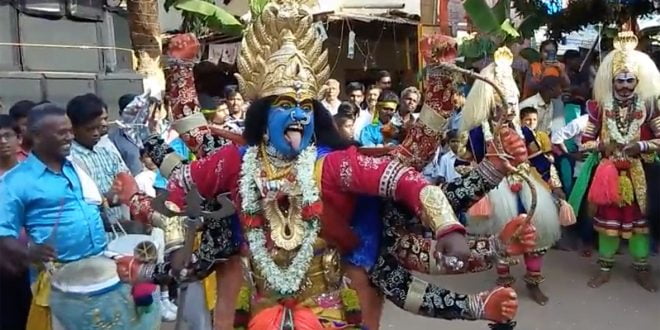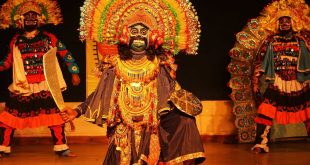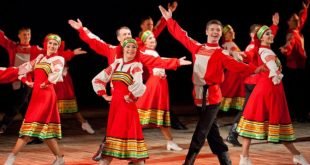Veeragase Folk Dance is a traditional dance form originating from the Indian state of Karnataka, characterized by its vibrant and energetic movements, expressive gestures, and mythological themes. It is performed with elaborate costumes, rhythmic footwork, and accompanied by traditional music and instruments. Veeragase dance holds religious significance and is often performed during festivals and celebrations, showcasing the valor of mythological heroes and local deities. The dance form has a rich cultural heritage and plays a vital role in preserving the traditional arts and fostering community cohesion
Origin and History of Veeragase Dance:
Veeragase Folk Dance is an ancient and captivating dance form that finds its roots in the cultural tapestry of Karnataka, a state in Southern India. The term “Veeragase” is derived from two Kannada words: “Veer” meaning brave or heroic, and “Gase” referring to dance. Thus, the dance’s very name reflects its central theme – the depiction of valor, courage, and heroism through graceful movements and expressive gestures.
The history of Veeragase Dance dates back centuries, with its origins deeply intertwined with mythology and folklore. According to popular belief, the dance was initially introduced as a means of worship and devotion to Hindu deities and mythological heroes. The performers, known as “Veeragase artists” or “Kamsale artists,” pay homage to various celestial beings, especially to Lord Shiva and Goddess Durga, through their artistic expressions.
This captivating dance form also holds historical significance as it served as a medium for conveying tales of legendary warriors and historical events to the masses. Over the years, Veeragase Dance has evolved and absorbed influences from various regional traditions, adding to its richness and diversity.
Traditionally, the dance was passed down through generations as a sacred family heritage. Guru-Shishya Parampara, the age-old tradition of teacher-disciple relationship, played a pivotal role in preserving and nurturing this art form. However, in recent times, the dance has also found its way into public performances, reaching a broader audience and gaining recognition as an essential aspect of Karnataka’s cultural identity.
Veeragase Folk Dance continues to thrive as a symbol of cultural pride and heritage. It exemplifies the vibrant spirit of the people of Karnataka and serves as a reminder of the valor and bravery celebrated through artistic expression. As this traditional dance form perseveres through the ages, it not only connects communities but also acts as a living testimony to the rich cultural legacy of Karnataka.
Mythological Significance of Veeragase Folk Dance:
Veeragase Folk Dance holds profound mythological significance as it draws its inspiration from the rich tapestry of Hindu mythology and ancient folklore. The term “Veeragase” itself denotes the portrayal of bravery and heroism through dance, reflecting the dance form’s deep connection with the tales of mythological heroes and celestial beings.
In Veeragase Dance, various characters from Hindu epics and mythological narratives come to life through the expressive movements and gestures of the performers. The dance often showcases the valorous exploits of mythological figures such as Lord Shiva, Goddess Durga, Lord Krishna, and the Pandava brothers from the Mahabharata.
Through captivating choreography and symbolic mudras (hand gestures), the dancers vividly depict the battles fought by divine entities, the triumph of good over evil, and the ultimate victory of righteousness. Each performance becomes a visual retelling of legendary stories, offering audiences a glimpse into the rich mythological heritage of India.
The dance form also has a significant association with religious rituals and festivals. In many regions of Karnataka, Veeragase Dance is performed during religious processions, temple festivals, and other auspicious occasions to invoke blessings and celebrate the divine grace of the mythological deities.
Furthermore, Veeragase Dance serves as a medium of spiritual expression and devotion, as the performers immerse themselves in the roles of the characters they portray, embodying the divine essence during their artistic presentations. The dance becomes a spiritual offering, merging art with devotion and spreading a sense of piety among the participants and spectators alike.
Overall, the mythological significance of Veeragase Folk Dance not only preserves the cultural and religious heritage of Karnataka but also serves as a bridge between the ancient stories of valor and the present-day audiences, keeping the rich mythological traditions alive in contemporary times.
Historical Background of Veeragase Folk Dance:
Veeragase Folk Dance boasts a fascinating historical background that traces its roots to the cultural and religious heritage of Karnataka, India. The dance form has a time-honored tradition, dating back several centuries, making it an integral part of the region’s artistic and social fabric.
The term “Veeragase” encompasses the essence of bravery and valor, reflecting the dance’s historical association with depicting the heroic deeds of mythological characters and local legends. Over the years, Veeragase Dance has evolved as a powerful means of storytelling, preserving the tales of ancient warriors and mythological heroes.
The historical origins of Veeragase Dance are deeply intertwined with the practice of Bhuta worship, a form of folk belief in which ancestral spirits and local deities are venerated. It is believed that Veeragase Dance was initially performed as a sacred ritual to invoke the blessings and protection of these spirits, ensuring the well-being and prosperity of the community.
As the dance form evolved, it assimilated influences from various regional traditions and cultural exchanges, adding layers of complexity and depth to its artistic expression. The dance not only became a form of spiritual devotion but also served as a platform for showcasing the rich cultural heritage of Karnataka.
Throughout history, Veeragase Dance has been nurtured and preserved through oral traditions and the Guru-Shishya Parampara, where the knowledge and techniques were passed down from generation to generation by accomplished dancers and teachers. This cultural continuity has contributed to the authenticity and longevity of Veeragase Dance as a living legacy of Karnataka’s history and traditions.
In the modern era, Veeragase Folk Dance has gained recognition beyond its traditional boundaries, finding its place on national and international stages. Cultural organizations, government initiatives, and art enthusiasts have played a vital role in promoting and safeguarding this ancient art form, ensuring that it remains a vibrant part of Karnataka’s cultural landscape.
Overall, the historical background of Veeragase Folk Dance is a testament to the enduring spirit of Karnataka’s artistic heritage, encapsulating a vivid narrative of bravery, devotion, and artistic evolution that continues to resonate with audiences across the globe.
Costumes and Props in Veeragase Folk Dance:
Veeragase Folk Dance, with its roots in the cultural heritage of Karnataka, showcases a splendid array of colorful and elaborate costumes, as well as distinctive props that enhance the visual allure of the performance. The costumes worn by the performers are not only aesthetically pleasing but also hold symbolic significance, reflecting the themes and characters portrayed in the dance.
The traditional attire of Veeragase dancers is an exquisite blend of vibrant colors and intricate embellishments. Male performers often don a traditional dhoti (a cloth wrapped around the waist) adorned with decorative borders and pleats, along with a striking turban or headgear, which varies based on the specific character being portrayed. The upper body is typically covered with a beautifully crafted and richly embroidered Angavastram (shawl) or a matching jacket.
On the other hand, female dancers showcase their grace and elegance through attire characterized by a brightly colored saree or a traditional Kasavu Pattu saree, native to the region, featuring gold or silver borders. The saree is draped in the traditional Nivi style, adding a touch of sophistication to the overall appearance. The dancers also embellish their attire with exquisite jewelry, including necklaces, bangles, earrings, and anklets, adding a touch of glamour to their performance.
In addition to the captivating costumes, Veeragase Folk Dance incorporates specific props that enhance the storytelling aspect of the performance. One of the most iconic props used in this dance form is the “Kamsale.” The Kamsale is a unique musical instrument made of bronze or brass with cymbals attached to its ends. It is held in the hands of the dancer and played rhythmically during the performance, adding a mesmerizing audio element to the dance.
Another notable prop used in Veeragase is the “Kirita,” a decorative headgear or crown that is often worn by the dancers to depict the divine and heroic characters of the mythology. The intricate design and craftsmanship of these props further add to the grandeur and visual spectacle of the dance.
Overall, the costumes and props in Veeragase Folk Dance play a pivotal role in immersing the audience into the world of mythological tales and ancient folklore. They not only adorn the performers but also serve as cultural artifacts, preserving the essence of Karnataka’s artistic traditions and providing a captivating experience for spectators.
Traditional Attire in Veeragase Folk Dance:
Veeragase Folk Dance is not only renowned for its dynamic movements and captivating narratives but also for its exquisite traditional attire that adds an enchanting visual element to the performance. The dancers’ costumes reflect the cultural heritage of Karnataka, India, and play a significant role in portraying the characters and themes depicted in the dance.
The traditional attire worn by male dancers in Veeragase Dance exudes a sense of regality and elegance. It typically includes a dhoti, a traditional garment wrapped around the waist and extending down to the ankles. The dhoti is often adorned with intricate patterns and decorative borders, adding a touch of grandeur to the attire. Male performers also wear a striking turban or headgear, which varies based on the specific character they are portraying. The upper body is typically covered with a beautifully crafted and richly embroidered Angavastram, a shawl-like garment that drapes gracefully over the shoulders, enhancing the overall royal appearance.
On the other hand, female dancers in Veeragase Folk Dance showcase their grace and beauty through their traditional attire. They typically wear brightly colored sarees, which are long pieces of cloth elegantly draped around the body. The sarees often feature vibrant colors and intricate patterns, reflecting the rich cultural heritage of Karnataka. Additionally, the sarees are adorned with decorative borders, sometimes made of gold or silver thread, adding a touch of opulence to the costume.
To complete the traditional look, both male and female dancers embellish their attire with a range of ornate jewelry. This includes necklaces, bangles, earrings, and anklets, crafted with meticulous detail and symbolic significance. The jewelry not only enhances the dancers’ appearance but also holds cultural and traditional value, reflecting the customs and practices of Karnataka’s rich heritage.
The traditional attire in Veeragase Folk Dance is not just a visual spectacle but also an embodiment of the characters and themes portrayed in the dance. The vibrant colors, intricate designs, and the use of traditional textiles evoke a sense of cultural pride and artistic finesse, making Veeragase Dance an enthralling display of Karnataka’s traditional sartorial splendor.
Traditional Attire in Veeragase Folk Dance:
Veeragase Folk Dance, originating from Karnataka, India, boasts a resplendent display of traditional attire that adds an enchanting visual charm to the performance. The costumes worn by the dancers are not only aesthetically appealing but also hold deep cultural and symbolic significance, reflecting the essence of Veeragase’s rich heritage.
The traditional attire of Veeragase dancers is intricately designed to complement the dynamic and expressive nature of the dance. Male performers don a traditional dhoti, a fabric wrapped around the waist and extending down to the ankles, which allows for ease of movement during the vigorous footwork and dynamic choreography. The dhoti is often adorned with ornate patterns and vibrant colors, reflecting the cultural diversity and artistic finesse of Karnataka.
The male dancers further embellish their attire with a striking turban or headgear, meticulously crafted to signify the heroic characters they portray. Each headgear design holds specific mythological or historical connotations, amplifying the storytelling aspect of Veeragase Dance.
For the upper body, male dancers elegantly drape a beautifully embroidered Angavastram or shawl, enhancing their regal appearance. The Angavastram not only adds an element of grace but also symbolizes the nobility and valor of the characters portrayed, aligning with the dance’s central theme of bravery and heroism.
Similarly, female dancers in Veeragase Folk Dance exude elegance through their traditional attire. They wear brightly colored sarees, gracefully draped in various styles, which add fluidity to their movements and accentuate the expressive gestures. The sarees are often adorned with intricate patterns and exquisite borders, reflecting the artistry and craftsmanship of Karnataka’s textile heritage.
The dancers’ costumes are further enriched by the inclusion of traditional jewelry. Male and female performers alike adorn themselves with intricate necklaces, earrings, bangles, and anklets, each piece intricately designed to complement the overall look and resonate with the cultural aesthetics of Karnataka.
Overall, the traditional attire in Veeragase Folk Dance serves as a visual feast for the audience, transporting them into the realm of mythological narratives and cultural heritage. The meticulously crafted costumes, turbans, and jewelry embody the essence of Veeragase, showcasing the grandeur of Karnataka’s traditional clothing and preserving the rich artistic legacy of this ancient dance form.
Gallery
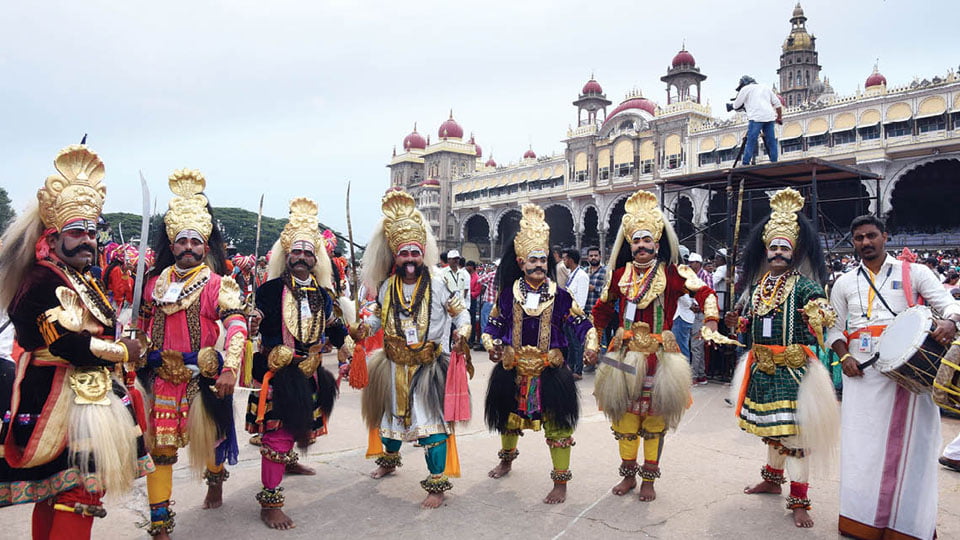
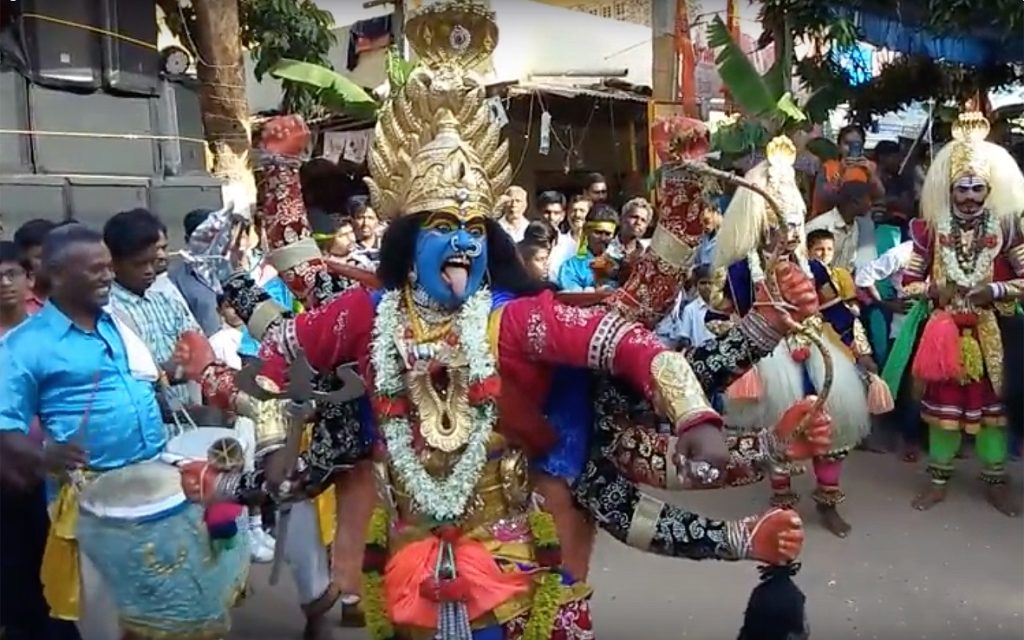
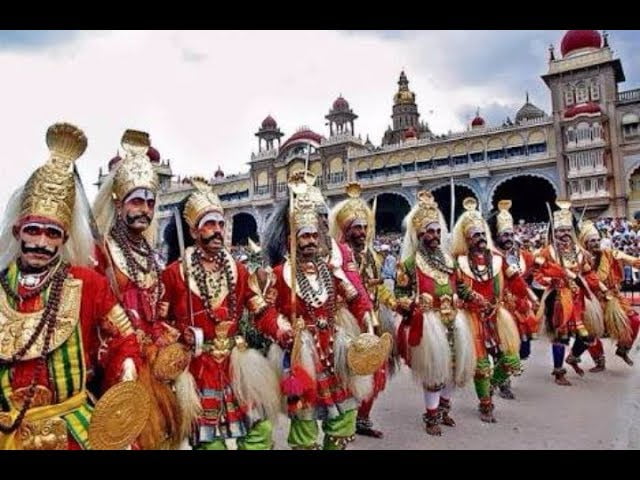
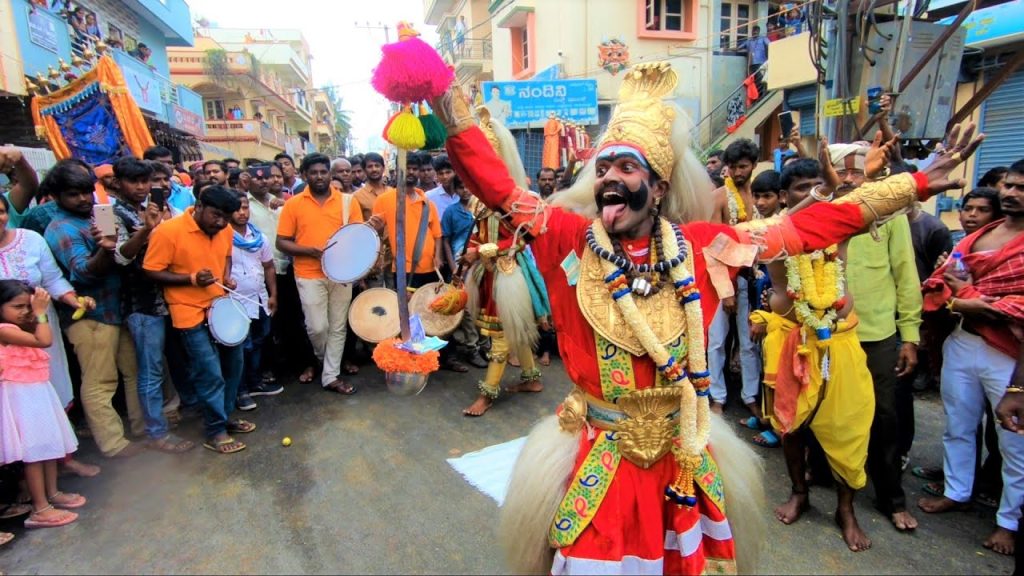
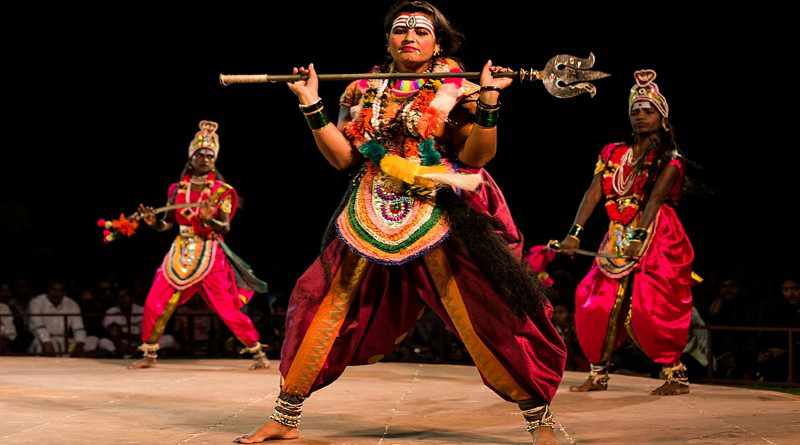
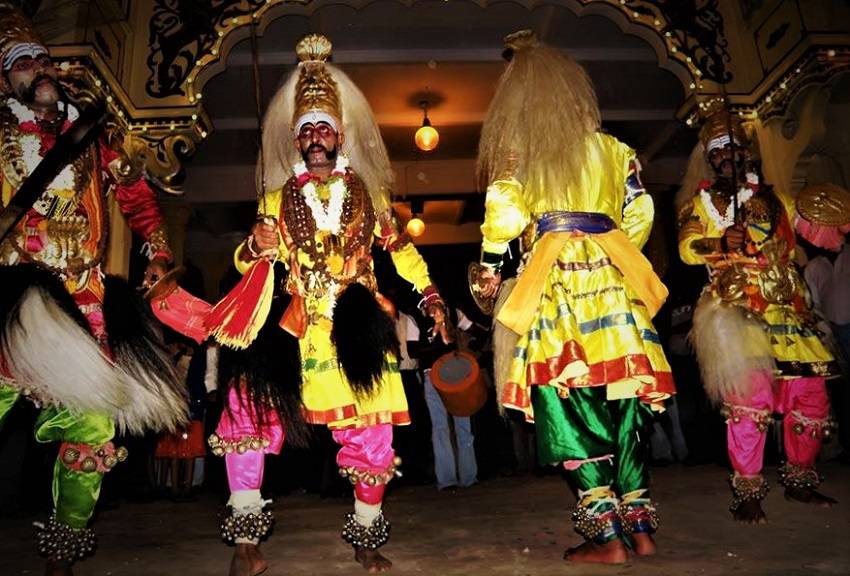
Video
Frequently asked questions about Veeragase Folk Dance
1. What is Veeragase Folk Dance?
Veeragase Folk Dance is a traditional dance form originating from the Indian state of Karnataka. It is characterized by vibrant movements, expressive gestures, and mythological themes, depicting valor, courage, and heroism through graceful performances.
2. What is the significance of Veeragase Dance?
Veeragase Dance holds religious and cultural significance. It is often performed as a means of worship and devotion to Hindu deities and mythological heroes. Additionally, it serves as a medium for preserving Karnataka’s cultural heritage and connecting communities through artistic expressions.
3. What are the costumes worn in Veeragase Dance?
The performers in Veeragase Folk Dance wear elaborate and colorful costumes. Male dancers typically wear traditional dhotis, decorative turbans, and embroidered shawls, while female dancers adorn brightly colored sarees with intricate borders and traditional jewelry.
4. What are some key features of Veeragase Dance movements?
Veeragase Dance is characterized by powerful and rhythmic footwork, expressive hand gestures (mudras), and dramatic body postures. The dance incorporates dynamic turns, spins, and leaps, showcasing the dancers’ skill, coordination, and physical stamina.
5. Where is Veeragase Dance performed?
Veeragase Folk Dance is primarily performed during religious festivals, cultural events, and celebrations in Karnataka. It is also presented in various stages and platforms to promote and preserve the traditional art form, attracting audiences from different parts of India and the world.
 FolkDanceWorld.Com International Folk Dances
FolkDanceWorld.Com International Folk Dances
